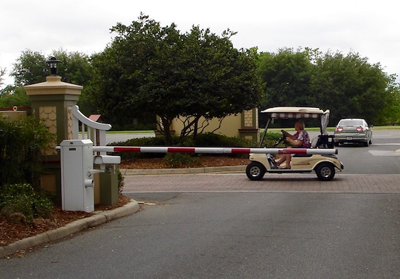The Evolution of Skills and Technology as PTVs Hit Public Roads in Greater Numbers
Most residents of most gated communities know what a PTV is. They also know that a PTV can be a certified LSV with a VIN number or can be upgraded to meet all LSV requirements. And there are many such upgrades, or even factory fresh vehicles with all LSV requirements, but do not come with a VIN number.
Securing a VIN may cost you extra dollars, but in most States you need the VIN in order to have legal access to public roads. As PTVs become more accepted as a component of the culture of American mobility, however, non-LSV certified vehicles are seen on the street. Complimenting this trend, on the other hand, are two offsetting factors which lend themselves to greater safety whether LSV-certified or not:
- Consistent upgrades in quality, such as four-wheel disk brakes, rack and pinion steering, and more powerful lighting and lighting kits;
- Passive safety features which mitigate against accidents and injuries. Examples are safety belts, automotive grade windshields, turn signals, back-up cameras, and side mirrors.
Of course, all current models do not have the full array upgrades, but as PTVs are now the major revenue producers for golf car manufacturers, as opposed to fleet sales, the incentives are in place for continuing upgrades of a wide diversity of types, emulating on-road automotive features.
Proactive vs. passive safety features will be the new and on-going trend in PTV upgrades
In a column published previously to the current one, proactive safety protections were described. They include collision alert, front obstacle detection, automatic emergency braking, and lane departure warning and correction. These features not only enhance driver and passenger safety, but, critically, they will serve to extend the market for PTV-type vehicles well beyond the golf course and the staid confines of a gated community. Thus, the prospective market for PTVs will extend into non-traditional (for them) environments, such as suburban neighborhoods and inner cities.

The National Highway and Traffic Safety Agency (NHTSA) established broad guidelines for golf car-type vehicles operating on public roads, the well-known CFR 500.571. States and local jurisdictions can follow these regulations and do so, but often with modifications to suit local environments. The list of safety features for PTVs has increased over the years, and now, for example, includes a backup camera.
Of course, all these guidelines and regulations go to the need for greater safety for drivers and occupants and pedestrians. Thus, it is almost a certainty that as technologies become available in the area of advanced driver assistance systems (ADASs), NHTSA’s guidelines for these systems, as pertaining to conventional vehicles will be extended to personal transportation vehicles, as well as last-mile delivery vehicles.
At the moment we can speculate that golf car manufacturers have proactive safety features on the radar screen, but, so far, no models have been announced with this technology.
Level 2 market entry from Taiwan-based Turing Drive
While all driver assistance systems have hardware, consisting of detection devices, such as cameras or Lidar technology, along with actuators that mechanically function to control the vehicle, the heart of an advance driver assistance system is the software, which integrates signals from the external environments and generates commands delivered to mechanical components of the vehicle, such as brakes and steering.
Turing Drive produces a level 2 ADAS, which translates into enhanced, proactive safety features, but with the driver remaining in control. The functions provided in the Turing Drive ADAS product are outlined below.
Turing Drive ADAS Technology for Golf Car-Type Vehicles
|
Offline Functions* |
Cloud Functions** |
|
|
Collision alert/automatic emergency braking |
Hazardous zone alert |
Remote locking and unlocking |
|
Precise vehicle positioning via sensor fusion technology |
Geofencing |
Event data recorder |
|
Lane departure warning/assistance braking |
Lane correction |
Front view video recorder |
Source: Turing Drive *Function capabilities within the golf car. **Functions programmed external to the vehicle, which control vehicle operations.
Compare the Turing Drive ADAS safety features with those In the table below, as recommended by NHTSA for conventional, on-road vehicles:
Collision warning systems recommended by NHTSA
|
System |
Purpose |
|
Forward collision warning |
Detects a potential collision with a vehicle and provides a warning to the driver |
|
Lane departure warning |
Monitors the vehicle’s position within the driving lane and alerts the driver as the vehicle approaches or crosses lane marker. |
|
Rear cross traffic warning |
Warns the driver of a potential collision, while in reverse, that may be outside the view of the backup camera. |
|
Blind spot warning |
Warns of a vehicle in the driver’s blind spot |
Source: National Highway and Safety Agency

As the market opportunity expands, proactive safety devices, such as those already defined by NHTSA will become commonplace as standard features on roadworthy PTVs. Companies that do not integrate these features in their vehicles will miss out in the emerging urban/suburban mobility (USM) market. Which leads to a further question: Are there companies actively involved in developing ADAS technology for PTVs? Turing Drive from Taiwan is one of these companies. Their technology is specially intended for integration in
Factors that will drive the market
Looking at the prospect for expanded use of PTVs in urban and suburban environments, and as this trend develops, this will involve a growing presence on public roads. This, in turn, will come under the scrutiny of public officials whose responsibility focuses on the oversight of traffic flow and safety. Therefore, private sector participants, such as manufacturers and dealers, will increasingly have to conform to the rules and regulations promulgated by these public officials. In this context here are the key factors that will drive what can call the urban/suburban mobility (USM) market:
- Effective interface and collaboration with public officials in charge of traffic safety and control;
- New forms of mobility, including ride-sharing and, in general personal transportation vehicles as a on-demand, fleet service, replacing private ownership;
- The ability to reach all communities and neighborhoods in a city or municipality—that is, effective participation in equitable mobility; and finally,
- Clear demonstration that PTVs participating in this expanded market are safe and incorporate the latest and best ADAS technology.
Evolution of dealer activity and expertise: Will a national dealers association be the next step?
As final note, the use of ADAS technology and entry into the USM market is not simply an issue of product quality and sophistication. Dealerships and company dealer networks are the industry’s foundation for sales and service. Taking the PTV of today to the next level will require an extensive effort, driven by corporate strategy and management direction, to educate and appropriately incentivize dealers in the requirements of this emerging market opportunity.
Aside from corporate vision and strategy implementation, look also for the emergence of a national dealers association. While having its own perspective on many issues, now and in the future, a national dealers association would insure that dealers and manufacturers effectively collaborate in a win-win process that can effectively build a model for growth and sustainability for the urban/suburban mobility market opportunity.
Contact the Author: Steve Metzger at smetzger@smallvehicleresource.com. Or check out our website at www.smallvehicleresource.com, where you will find an extensive database of vehicle models and can make side-by-side comparisons of vehicles based on a full set of specifications.



